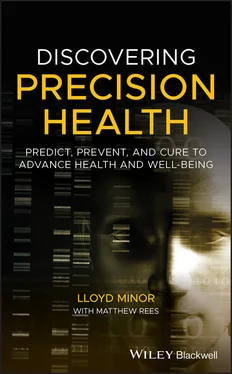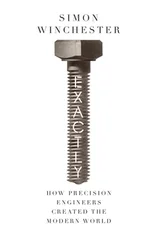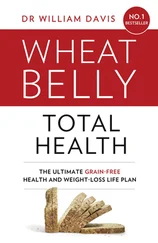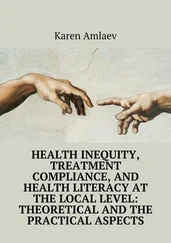The conference was hosted by the University of California, San Francisco (UCSF) in May 2013, just six months after I had become dean at Stanford. Susan Desmond‐Hellman, then the chancellor at UCSF, brought together leaders from biomedical research, medical practice, government, and industry—the meeting featured the director of the NIH, the governor of California, and the CEO of Facebook, among others. We were all there to discuss how to move from one‐size‐fits‐all treatments for diseases to medical care that is tailored to the distinctive features of each individual. This was billed as “precision medicine,” and it was timely. There was already evidence of the impact of applying genomics and data science to the treatment of severe acute diseases such as breast cancer. No longer was the same treatment recommended to all women based simply upon the size of the tumor and presence or absence of distant metastatic disease. The development of specific antagonists, whose efficacy was determined based upon specific receptors present or absent in tumors, was having a major effect on improved survival (and those effects are even greater today).
The discussions were stimulating and thought provoking. And while the “precision” part of the event intrigued me, I was struck by the focus on “medicine.” Everything on the agenda revolved around disease—almost as if it was inevitable. Curing disease is critical, of course, but preventing disease is even better.
Another influence on my thinking was a speech delivered by Elias Zerhouni, a former director of the NIH and later president of R&D for Sanofi. He spoke eloquently at a Stanford Medicine retreat in January 2014 about the need for a shift in the practice of medicine. While a focus on cures remained critically important, he recommended placing heightened emphasis on predicting and preventing disease. He also called for developing a better understanding of disease mechanisms. His talk built on a theme he had introduced during his time at NIH, which was for medicine to be predictive, personalized, preemptive, participatory.
The book that influenced my thinking was The Decision Tree , by Thomas Goetz, who at the time was executive editor of Wired magazine [16]. The “decision tree” of his title was a system that would help guide people toward the best decisions about their health—drawing on new science and new technologies, in particular. I found it to be an excellent overview of the different ways in which health and health care could be reoriented to focus more on prevention.
With all of that as a backdrop, in November 2014 I had breakfast at Buck’s—a popular restaurant a few miles from Stanford—with two professors at the School of Medicine, Peter Kim and Steve Quake. I had asked them to meet with me because I wanted to brainstorm about some of the overarching themes for the work of the medical school, and I knew I could count on them for insightful and creative ideas.
My colleagues and I had recruited Peter to join the faculty—his previous positions included leading global R&D for Merck and serving as a professor at MIT’s Whitehead Institute for Biomedical Research. Steve had developed a way of measuring and detecting cell‐free DNA, which was one of the greatest diagnostic advances of the first decade of the 21 stcentury. (I discuss it in more detail in chapter 5.)
We discussed several principles and topics—such as behavior, genomics, economics, measurement, prevention, and prediction. But the first two words I wrote in my notebook that morning were “precision” and “health.” With Steve’s background in diagnostics, we were able to talk about shifting the focus of health care so there would be more emphasis on the “health” part. The three of us agreed that Stanford was uniquely positioned to put forward a new vision, built around using prediction and prevention to advance health.
Our breakfast discussion led me to sketch out several ideas, which I presented in my closing remarks at a Stanford Medicine retreat in January 2015, at Fort Baker near San Francisco. I didn’t go into great detail—I just wanted people to hear some of my preliminary thoughts about Precision Health and I wanted their feedback. I was pleased that my thoughts seemed to strike a chord with many of those in attendance. In particular, the theme and the message resonated strongly with the then leaders of the two hospitals that are a part of Stanford Medicine: Amir Rubin, president and CEO of Stanford Health Care (SHC), and Christopher Dawes, president and CEO of Lucile Packard Children’s Hospital Stanford (LPCH). Since coming to Stanford, I had been searching for a theme that would bring the three entities of Stanford Medicine (School of Medicine, SHC, and LPCH) closer together: a theme that could help unite the different components of Stanford Medicine and advance its mission. We all agreed that Precision Health was exactly that theme.
Just a few weeks after our retreat, we were pleasantly surprised when President Obama held an event at the White House to announce a federal government initiative devoted to “precision medicine.” The objective, he said, would be “delivering the right treatments, at the right time, every time, to the right person” [17]. The initiative had five parts:
Using the federal government’s National Cancer Institute to help expand and improve research into cancer treatments
Working with the NIH to create a research group of one million people, known as “All of Us,” and using the data from that cohort to discover the causes—and eventually the cures—of deadly diseases
Modernizing regulation, with a focus on developing a new approach to evaluating next‐generation genetic tests
Expanding public‐private partnerships to enable development of the infrastructure needed for the cancer treatment research and the “All of Us” initiative
Protecting patient privacy
To help put precision medicine in perspective, the director of the NIH, Francis Collins, and the director of the National Cancer Institute, Harold Varmus, published an article on the website of the New England Journal of Medicine . They pointed out that it was now possible to bring more precision to medicine thanks to developments like biological databases (such as the human genome sequence), new forms of characterizing patients (such as proteomics and metabolomics), and new computational tools to analyze large data sets [18].
The Obama administration’s focus on “medicine” (treatment of diseases after they occur) contrasted with our focus on “health” (with more emphasis on prediction and prevention of diseases), but we interpreted the shared focus on “precision” as a signal that we were on the right track. We soon organized a faculty working group, led by the Department of Medicine chairman Bob Harrington, and including faculty and staff from the School of Medicine as well as from SHC and LPCH. That group spent more than a year developing the ideas that would define Precision Health. Their expert work led to the development of a comprehensive plan for Precision Health. The working group released its findings in October 2016, and since then we have been working to instill the Precision Health plan throughout the School of Medicine, SHC, and LPCH.
It’s been gratifying to see broad adoption of the theme and components of Precision Health throughout our enterprise. David Entwistle, who began as president and CEO of SHC in July 2016, and Paul King, who began as president and CEO of Lucile Packard Children’s Hospital and Stanford Children’s Health in February 2019, have firmly embraced the vision. After David’s arrival, we were able, for the first time, to develop a truly integrated strategic plan for Stanford Medicine, with Precision Health being the unifying principle. Marc Tessier‐Lavigne, who became Stanford’s 11 thpresident on September 1, 2016, and who has previously worked as a neuroscientist, biotechnology executive, and president of a biomedical research university, has endorsed Population and Precision Health as an important strategic objective for Stanford University’s research community.
Читать дальше












